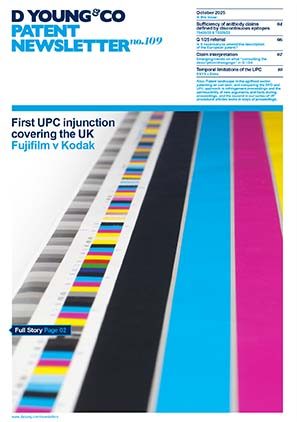Infringement proceedings: conflicting EPO & UPC outcomes
On 21 July 2025 the UPC released its decision (ORD_598566/2023) on the long-running Edwards Lifesciences Corporation v Meril Life Sciences Pvt Ltd infringement proceedings. The decision, handed down by the Nordic-Baltic Regional Division of the UPC, brings this case one step closer to a conclusion, whilst also raising further questions regarding the interplay between the EPO and the UPC.
In this article, we discuss the outcome of the proceedings, in particular the implications of conflicting outcomes from concurrent EPO and UPC proceedings.
Background
Edwards Lifesciences Corporation specialise in artificial heart valves. Edwards produce the SAPIEN family of transcatheter heart valves (THVs) as well as catheter systems for their implantation. Catheter systems allow heart valves to be implanted through minimally invasive procedures, removing the need for open heart surgery. Edwards is the proprietor on a number of patents relating to the implantation of transcatheter aortic valves including EP3769722, which is the subject of these proceedings.
Meril Life Sciences PCT limited is based in India with a European subsidiary, Meril GmbH, which is based in Germany. Meril also produce a transcatheter heart valve which uses a balloon catheter delivery system marketed as the Navigator THV delivery system.
Edwards’ SAPIEN THV was the only balloon expandable THV on the market until Meril released its Myval system.
Meril initially distributed the Myval system across Europe. However, cease and desists and/or injunctions (for example, UPC_CFI_501/2023) limited its sale to only a few countries.
On 27 October 2023 Edwards initiated an action for infringement against Meril Life Sciences PCT and Meril GmbH claiming it infringed EP3769722 by placing the Navigator system on the market in UPC member states including Estonia and Lithuania. Edwards also initiated an action of infringement against SMIS International OÜ, Sormedica, Interlux and VAB-Logistik UAB who were Meril’s distributors in Lithuania and Estonia.
Meril denied infringing EP3769722 and counterclaimed for revocation. The panel decided to hear the action for infringement and the counterclaim for revocation together.
Opposition proceedings at the EPO were ongoing when the UPC actions were initiated. The oral hearing before the UPC was scheduled for 16 January 2025, one day before the EPO oral proceedings, which were scheduled for 17 January 2025. Given the proximity of the two hearings, a petition to stay the UPC proceedings was raised but subsequently denied. The UPC requested the parties to inform the court of the outcome of the EPO’s oral proceedings.
During the EPO oral proceedings, the Opposition Division found the claims of EP3769722 as granted to be unallowable on the grounds of added subject matter. The patent was eventually upheld on the grounds of auxiliary request AR1’. AR1’ comprised an amended claim 1 as well as the deletion of dependent claims 7 and 9 to 11.
Revocation proceedings
The auxiliary request which the patent was upheld on during the EPO oral proceedings was not submitted in the UPC proceedings. During the written proceedings, Edwards submitted 22 auxiliary requests, along with a detailed explanation as to the order in which to move through the requests. During the UPC oral proceedings, Edwards argued that if the court agreed with the EPO Opposition Division then it could uphold the patent on the grounds of auxiliary request 1 with further amendments to delete claims 7 and 9 to 11, to bring the claims in line with the claim set deemed allowable during the EPO opposition proceedings. These specific amendments did not align with any auxiliary request submitted during the UPC proceedings.
Meril argued that it should move through the requests in order. The court stated Edwards had made it clear how to proceed through the auxiliary requests and denied Edwards’ petition.
Initially, in line with the EPO, the court ruled that claim 1 and multiple dependent claims added subject matter. However, the court upheld the patent on the grounds of AR1’ which contained the same amended claim 1 as the allowable EPO auxiliary request, but with all dependent claims deleted.
Conflicting outcomes
It is currently unknown how the conflicting outcomes of the UPC and EPO opposition proceedings will affect the scope of EP3769722. Appeal proceedings at the EPO are currently ongoing, therefore there is still a chance the claims will end up aligned.
It is clear the claims deemed allowable by the EPO will be in-effect in EPO member states which are not UPCA signatories (UK, Spain, Switzerland, Poland, and so on). It is not clear which decision will take precedence in UPC member states. The UPC has stated in Carrier v Blitzer (ORD_25123/2024) that if one body upholds a patent and the other revokes, then the revocation will take precedence.
No case law currently exists relating to patents upheld on differing claim sets, however there are other ongoing proceedings with the same issue. One example is NJOY Netherlands BV v VMR Products LLC. The patent in question, EP3613453, was maintained with differing claims in concurrent UPC and EPO opposition proceedings. The EPO decision has been appealed, with oral proceedings scheduled for 11 November 2025.
Infringement proceedings
The infringement proceedings centred on the first section of the one remaining claim of EP3769722, which reads as follows: “An apparatus for indicating the flex of a distal end of a catheter comprising an elongated shaft (152); at least one pull wire (174) connected to a distal end portion (188) of the elongated shaft (152); a handle portion (158) comprising a flex activating member (154), activating member (154) being coupled to the at least one pull wire (174) such that adjustment of the flex activating member (154) causes the distal end portion (188) of the elongated shaft (152) to flex; […]”
During the revocation proceedings, the parties argued over the term “elongated shaft”. Meril argued the “elongated shaft” must be understood to belong to the guide catheter, which is to be distinguished from the balloon catheter.
Meril further argued during the infringement proceedings that the Navigator does not infringe EP3769722 as it consists solely of a single balloon catheter, without a guide catheter. The single catheter consists of an inner and outer shaft, and where the valve is crimped directly onto the balloon.
Edwards argued that the elongated shaft does not necessarily belong to the guide catheter and that Meril was simply quoting an exemplary embodiment.
The court ruled that it is clear to the skilled person in the art that the elongated shaft comprised in the apparatus for indicating flex of a distal end of a catheter as claimed can be, but is by no means mandatorily a guide shaft of a guide catheter.
Edwards replied stating that although the Navigator system comprises a single catheter with two shafts, the distal end of the outer shaft is in direct communication with the device’s balloon. Edwards argued this feature constitutes an “elongated shaft”.
The court found the Navigator system infringes claim 1 of EP3769722. The court concluded that claim 1 covers both a guide catheter and a balloon catheter, and balloon catheters that do not comprise a guide catheter. The court also found the Navigator comprises an elongated (balloon catheter) shaft that is comprised of an outer and an inner elongated shaft, as found in amended claim 1 of EP3769722.
The court ordered the recall and destruction of all infringing products placed on the market in the relevant member states. The court further ruled that information on the distribution channels of the infringing articles be provided to Edwards. Edwards was awarded an interim award of €500,000, with the total amount of damages to be decided in a separate proceedings. Edwards was also awarded 100% of its costs for the infringement action and 75% of the costs for the counter claim for revocation.
Conclusions
This decision by the UPC brings us one step closer to the conclusion of this long-running case. However, appeal proceedings at the EPO are still ongoing with oral proceedings set for 03 March 2026.
We will continue to keep our eye on future developments in this case, to see how conflicting outcomes between the EPO and UPC are resolved. If you are seeking any advice with respect to infringement at the UPC, please contact your usual D Young & Co representative for further information.
Case details at a glance
Decision level: Nordic-Baltic Regional Division
Citation: ORD_598566/2023
Parties: Edwards Lifesciences Corporation v Meril Life Sciences PVT Limited, VAB-Logistik, UAB, SMIS International OÜ, Meril GMBH, Sormedica, Interlux
Date: 21 July 2025
Decision: dycip.com/UPC-ORD-598566-2023

